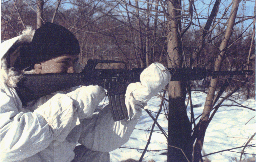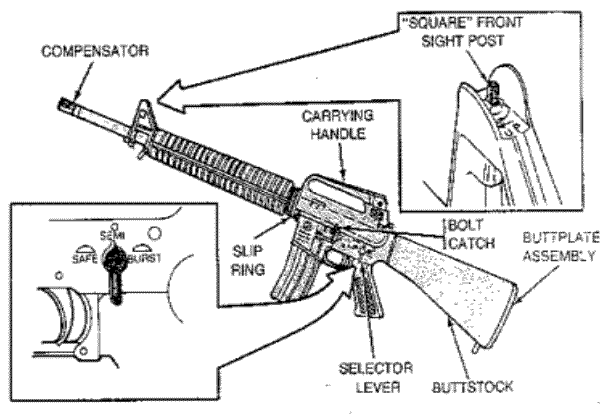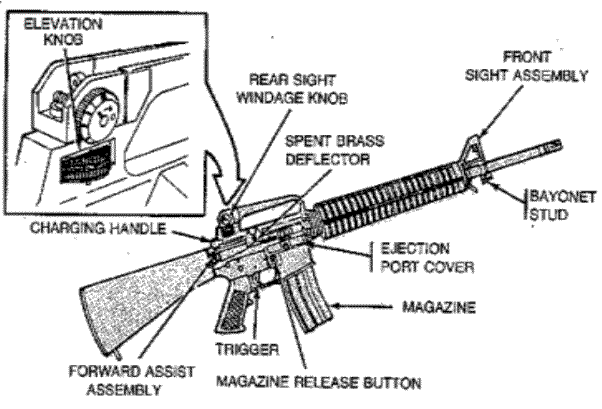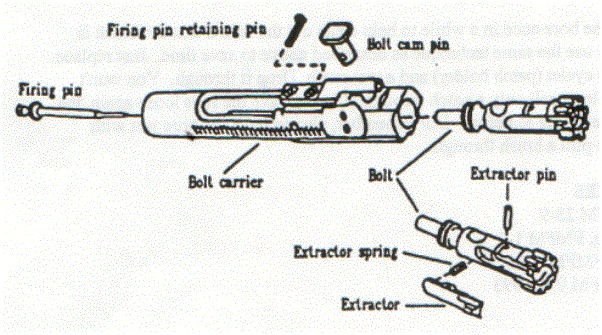|
M16A2 5.56 mm Rifle
|
 The M16A2 rifle is a 5.56mm, magazine-fed, gas-operated,
air-cooled, shoulder-fired weapon that can be fired either in automatic
three-round bursts or semiautomatic single shots as determined by
the position of the selector switch. The M16A2 rifle is a 5.56mm, magazine-fed, gas-operated,
air-cooled, shoulder-fired weapon that can be fired either in automatic
three-round bursts or semiautomatic single shots as determined by
the position of the selector switch.
-
The upper receiver and barrel assembly has fully
adjustable rear and front sights and a compensator that helps keep the
muzzle down during firing.
-
A rubber pad mounted on the butt stock and a buffer
assembly inside the butt stock helps absorb the recoil when fired.
-
The barrel is surrounded by two aluminum lined
Fiberglass hand guards which are notched to permit air to circulate
and cool the barrel and also protect the gas tube.
-
A bayonet and/or bipod can be attached to the barrel
of this weapon individually or at the same time.


To Load:
-
Point the rifle in a safe direction.
-
Take a loaded magazine and shove it firmly into the weapon until you hear
a "click."
-
Tug downward on the magazine to make sure it is completely engaged and
does not pull out of the weapon.
-
Pull the "Charging Handle" straight back until it won't go any
further, then release it. It will spring back to its' original position,
cocking the internal hammer and bringing a cartridge into the firing
chamber. The weapon is now loaded and will fire if you pull the trigger.
-
If you do not intend to fire the weapon immediately, move the
"Selector Lever" switch from "Semi" or "Burst"
to "Safe," and close the "Ejection Port Cover."
To Fire:
-
Aim a loaded rifle at the target.
-
Using your thumb, move the "Selector Lever" from
"Safe" to "Semi" or "Burst."
-
Squeeze the trigger and the weapon will fire.
-
If you have the "Selector Lever" on "Semi," you will
fire a single round. If it is on "Burst," the rifle will
automatically fire three rounds in a burst.
-
In either case, you can continue pulling the trigger and each time, the
trigger pull will fire the rifle, and the gasses from the bullet will cause
the rifle to eject the empty cartridge and bring a new cartridge into the
firing chamber.
-
You don't have to worry about the "Ejection Port Cover" being
open or closed. If it is closed and the weapon wants to eject a cartridge,
the Ejection Port Cover will be automatically forced open and will remain
open until you decide to close it.
To Unload:
-
Point the rifle in a safe direction.
-
Attempt to move the "Selector Lever" to "Safe."
-
Using your right index finger, depress the "Magazine Release
Catch" just above the trigger guard on the right side of the rifle, and
then remove the magazine from the weapon. (They often just fall out as soon
as you press the release catch.
-
After the magazine is removed, pull straight back on the
"Charging Handle" to eject any round from the firing
chamber.
-
Look through the ejection port to visually confirm that there is no
cartridge in the firing chamber. Then release the Charging Handle and let it
spring forward to its' normal position.
-
Place the "Selector Lever" to "Safe."
-
Close the "Ejection Port Cover."
Clearing the Rifle:
-
Clearing a weapon means unloading the it and leaving it in a status that
it is visually obvious to anyone who sees it that it is empty and
temporarily disabled.
-
To clear the M16A2 rifle, remove the magazine, pull the "Charging
Handle" backward and lock in the open position, move the "Selector
Lever" to "Safe" and leave the "Ejection Port
Cover" open. This is the safest way to leave the weapon.

Helpful Tips in Using this Weapon
-
Although the projectile will travel up to two miles, its' maximum
effective range is about 300 meters, in practiced hands, in daylight, with a
stationary, man-sized target. Most medical personnel won't be able to
achieve those results, so try to hold your fire 'til you "see the
whites of their eyes."
-
Effective rifle fire, other than at point blank range, requires careful
sighting (aligning the front and rear sights with the target), breath
control (try not to breath while firing), a smooth, steady trigger pull (try
to avoid jerking the trigger), and avoidance of "flinching" in
anticipation of the weapon firing. The latter can be avoided through
practicing "dry fire" techniques.
-
In the event of a misfire, try the Slap, Rack, Bang procedure:
-
Slap the magazine upward to more firmly seat it in the
weapon.
-
Rack back the "Charging Handle" and release
it, ejecting the misfired round and bringing a fresh round into the
firing chamber. Let the the "Charging Handle" spring back on
its' own...don't "ride" it back.
-
Bang goes the rifle when you pull the trigger.
-
When defending against multiple targets, try to stop the most threatening
target first. Usually that is the target closest to you. However, someone
with an automatic weapon or shotgun is more dangerous to you and your
patients than someone with a
pistol. Likewise, someone with a rifle is more dangerous than someone with a
pistol.
-
Take advantage of any cover you may have. Crouching behind a rock or
packing crate is much better than standing out in the open. If you are caught out
in the open, quickly make a decision to either go to the ground, or to run
to cover. If you go to ground, keep moving (rolling, crawling), to decrease
the chance of your being wounded.
-
Should you become wounded, keep shooting. The best defense against
incoming fire is to return fire, wounded or not.
For additional information, read:
M16A2 Assault Rifle
Familiarization, FMSS Class 0210
FM
21-75: Combat Skills of the Soldier
More Information on Operational Safety |
From Operational Medicine 2001:
Health Care in Military Settings
CAPT Michael John Hughey, MC, USNR
NAVMED P-5139
January 1, 2001
Bureau of Medicine and
Surgery,
Department of the Navy,
2300 E Street NW,
Washington, D.C,
20372-5300
United States Special Operations Command,
7701 Tampa Point Blvd.,
MacDill AFB, Florida,
33621-5323
Home
·
Textbooks and Manuals
·
Videos
·
Lectures
·
Distance Learning
·
Training
·
Operational Safety
·
Search
This website is dedicated to the development and dissemination of medical information that may be useful to those who practice Operational Medicine. This website is privately-held and not connected to any governmental agency. The views expressed here are those of the authors, and unless otherwise noted, do not necessarily reflect the views of
the Brookside Associates, Ltd., any governmental or private organizations. All writings, discussions, and publications on this website are unclassified.
© 2006 Medical Education Division, Brookside Associates, Ltd. All rights reserved
Contact Us

|
|
 The M16A2 rifle is a 5.56mm, magazine-fed, gas-operated,
air-cooled, shoulder-fired weapon that can be fired either in automatic
three-round bursts or semiautomatic single shots as determined by
The M16A2 rifle is a 5.56mm, magazine-fed, gas-operated,
air-cooled, shoulder-fired weapon that can be fired either in automatic
three-round bursts or semiautomatic single shots as determined by

